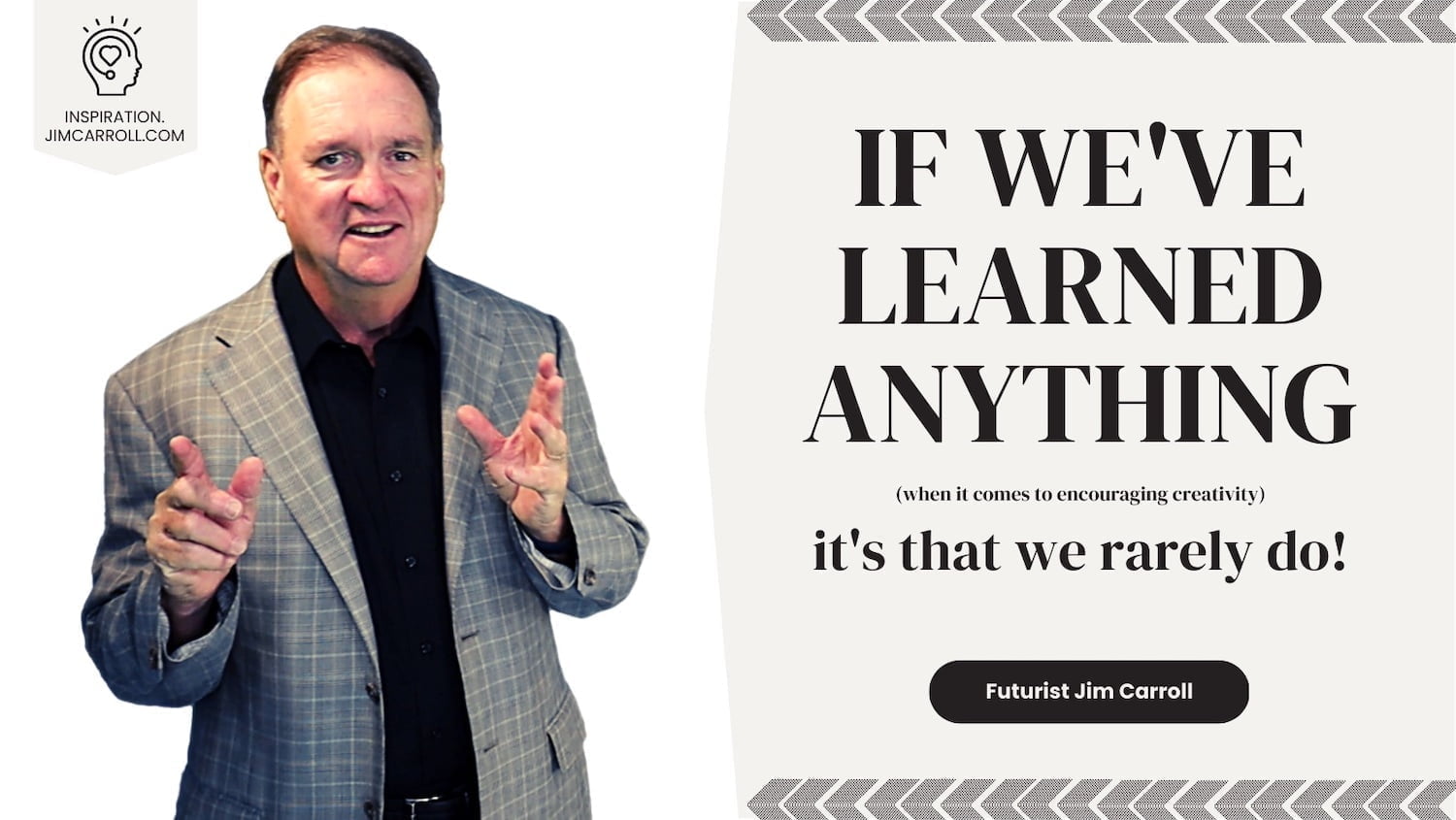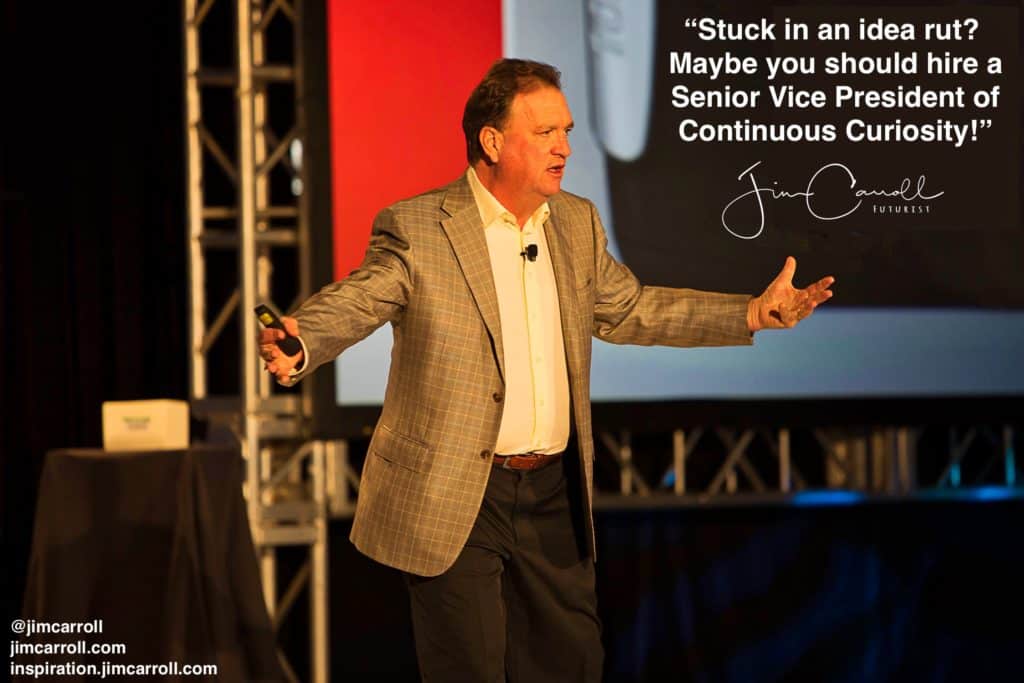“If we’ve learned anything (when it comes to encouraging creativity) it’s that we rarely do!”

Every once in a while, for some reason or other, a page on my Web site takes off and gets shared around a lot. Sometimes, a BIG lot!
At the end of last year, my list of ‘10 Great Words for 2022‘ went to the #1 spot for anyone searching for the phrase ‘define 2022” or similar ideas I found that I was suddenly getting hundreds of hits, and sometimes, thousands of hits per hour on the page on my site – and was getting charged overage fees by my hosting provider as a result. Because of that, I just completed a project to move my Website over to a new server and hosting company with such penalties to compensate. Not fun – it was costing me to be popular!
 I noticed the same thing happening last week with a post that I wrote a few years back about curiosity. What Every Organization Needs: A Senior VP of Curiosity [ link ], was getting shared, albeit not as widely, but certainly enough that it grabbed my attention. Curious again curiosity, I decided that it would be a good time to revisit the topic once again. My research led me to a wonderful study out of Australia/New Zealand, “Capitalizing on Creativity: How business can thrive through uncertainty.”. Sponsored by SAP, the study takes a look at the elements and need for curiosity as a key driver of innovative thinking, particularly in the context of fast-moving post-pandemic change. [ link ] You can also download a PDF here.
I noticed the same thing happening last week with a post that I wrote a few years back about curiosity. What Every Organization Needs: A Senior VP of Curiosity [ link ], was getting shared, albeit not as widely, but certainly enough that it grabbed my attention. Curious again curiosity, I decided that it would be a good time to revisit the topic once again. My research led me to a wonderful study out of Australia/New Zealand, “Capitalizing on Creativity: How business can thrive through uncertainty.”. Sponsored by SAP, the study takes a look at the elements and need for curiosity as a key driver of innovative thinking, particularly in the context of fast-moving post-pandemic change. [ link ] You can also download a PDF here.
The study echoes my thinking in almost every respect and backs up the data in my earlier post. Back then, I reported on the First International Curiosity Study sponsored by the drug company, Merck. (I still don’t know what happened to the ‘second’ study – it’s never come out! I’m curious!)
Consider some of the findings:
- more than 8 out of 10 people agreed that “a curious person is more likely to bring an idea to life at work“
- even so, innately curious – only 20% did!
- instead, the majority described themselves as ‘organized, collaborative and detail-oriented’
- curiosity came in 12th place on a list of attributes! (funny and talkative beat out curiosity, if you can believe it!)
How did the study define curiosity? Inquisitiveness, creativity, openness… and yet, all of that was stifled.
- 73% of those surveyed did not feel comfortable asking more questions at work
- 50% in Germany indicated that they feel discouraged by their employee from changing the status quo!
- only 9% felt that the organizations they worked for were “extremely encouraging’ of curiosity
- 61% indicated that the organization was not at all encouraging it, or only somewhat encouraging it
The SAP study echoes the same finding: 8 out of 10 business leaders in Australia and New Zealand believe that while curiosity is important to their organizations, fewer than 4 in 10 employees believe that their organization has a ‘curiosity culture.’ Leadership thinks they are doing a great job to encourage creativity at work – but few employees agree. Leadership – all talk, no reality!
What is a curiosity culture? The study defined it this way:
A culture of curiosity is an organizational culture where employees are encouraged and enabled to ask questions and seek answers to help organizations run better and meet the needs of their customers, employees and the community.
Why is curiosity important? The introduction to the study did a great job of identifying this, noting that:
How do leaders ensure their organization meets customer expectations when they change so fast? How can they improve supply chain visibility to identify disruptions and take corrective action? What is needed to keep people engaged while they embrace hybrid work? And how do we all work together to solve some of society’s biggest
challenges, like sustainability? We believe the answer lies in tech-powered innovation and building a culture of curiosity to unlock this potential within an organization.
Here’s what this means: many organizations, in the face of rapid business model change, technological, competitive, social, and political change, have staff that remain in a drone-like state, focused on getting things done, rather than figuring out how to do things better! This pretty much echoes what I have been saying for so many years. To move forward and come up with innovative solutions to complex problems, achieve growth, and align with the future, we need more creativity! That’s why I’ve recently elevated the importance of my creativity keynote topic, highlighting my proposed degree for a Masters in Business Imagination!
Accelerating Creativity: Discovering Opportunity With an Innovation Reboot!
We will see more change in every industry in the next 10 years than we have seen in the last 100 as transformation and disruption sweeps the world.
Every company is faced with the rapid emergence of new competitors, significant new business models, more challenging consumers, the acceleration of science, and a transition to the speed of innovation that will define their future.
How do you manage this complex new world and get ahead? By turning on your innovation engine, firing your creativity thrusters, and strapping in for a rocket ride into your faster future. You need to accelerate your ability to generate radical new ideas and transformative concepts. You need innovation creativity!
In this keynote, futurist and innovation expert Jim Carroll shares the innovation and creativity insight that he has gained through three decades of a relentless focus on what turns organizations into high-velocity innovation and creativity heroes. None other than NASA has invited Jim in – twice – to share his insight on innovation strategies. Disney – a creativity superhero – invited him in for a keynote on the opportunities that come from rethinking creativity. The World Bank engaged him for a talk that linked fast-moving future trends to the need for accelerated innovation and fast thinking.
Jim’s keynote will share with you the key elements of his imaginary but powerful “Masters in Business Imagination” curriculum – a structure of 10 key leadership strategies, actions and structures that will help you envision opportunity, think differently, and act quickly.
Launch yourself into the faster future with this unique, high energy creativity focused keynote from global futurist, trends & innovation expert Jim Carroll!
There’s a lot of wonderful insight in the SAP report – I’d really recommend reading it. Consider this gem, which closely aligns with my thinking:
Research suggests that being able to challenge and debate ideas and assumptions is critical for building a curious culture
How many times do you see me suggesting that the path to getting ahead is more collaboration, chasing diversity of thinking, avoiding hiring people who are all the same, challenging assumptions, habits, and routines….. and yet organizations don’t do this? Read my “Innovation Killers” and then read the “Curiosity Barriers’ in the report. Whoah – close alignment!
What should we do with the observations from such a study? The study itself offers a number of suggestions, such as ‘starting with customer frustrations,’ (upside down innovation which I wrote about last week), ‘finding the right amount of challenge’, taking on risk, experimenting more, freeing up people to explore ideas, and this wonderful one – having more arguments! Being Canadian – sorry, I agree!
My advice? Going back to my original post:
Clearly, since we know that curiosity is at the root of much of innovation, the ideas should be obvious for anyone with a curious mind: hire someone to fire up your curiosity!

Bottom line? I
If you are stuck in an idea rut? Maybe you should hire a Senior Vice President of Continuous Curiosity!




GET IN TOUCH
Jim's Facebook page
You'll find Jim's latest videos on Youtube
Mastodon. What's on Jim's mind? Check his feed!
LinkedIn - reach out to Jim for a professional connection!
Flickr! Get inspired! A massive archive of all of Jim's daily inspirational quotes!
Instagram - the home for Jim's motivational mind!